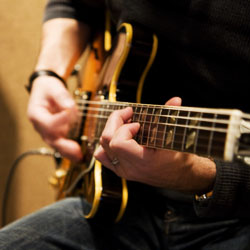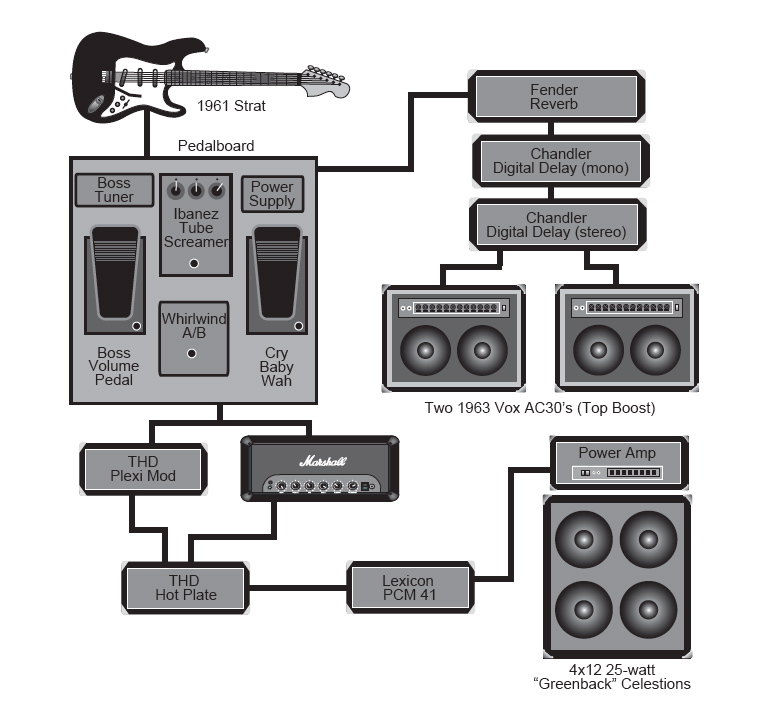
Eddie Van Halen
He’s come a long way from the days when he would just plug a “Frankenstein Strat” into an MXR Distortion+ and a Phase 90. Actually, the Phase 90 is still in his rig, but Eddie’s setup has become a little more sophisticated.
He gets all of his distortion from the amps, whether Marshalls or Peavey 5150s.
The amp switcher can select the path between the Marshall and Peavey, and the timebased effects (which include Eventides, Rolands, and Lexicons) all come via the amps’ effects sends.
After going from the amp preamps to the effects sends to the effects rack, the signals are not returned, so the power amp section of the Marshalls and Peaveys never gets used.
Instead the signals are sent to three pedals (a Cry Baby wah, a Boss OC-2 octaver, and the abovementioned Phase 90) before going into a rack containing speaker simulators and power amps.
The speaker simulators are necessary to take the high-end edge off of the line-level signals from the Marshalls’ and Peaveys’ preamp sections.
After being simulated, the line-level signal is delivered to the power amps and sent to three 4✕12 cabinets.
Stevie Ray Vaughan
He was a little bit blues and a little bit rock and roll. Stevie Ray Vaughan’s setup gave a nod to Hendrix, with the Vox wah in front and the Diaz Square Fuzz and Tycobrahe Octavia in the chain.
Vaughan also employed a Boss chorus pedal and a real Leslie before driving an armada of Fender-made amps.
Vaughan also played through a Marshall configured with 6550 power tubes instead of EL34s.
Carl Verheyen
Studio ace Carl Verheyen uses a combination of devices from pedals to rack-mount gear, but he essentially runs two paths: clean and distorted.
For his distorted sound, he goes through his pedalboard (which contains such front-end devices as a Cry Baby wah and an Ibanez Tube Screamer) and then into either a Marshall head or a THD modded Plexi.
The speaker outs of both heads are run through a load box (the THD Hot Plate) to convert them to line level.
At this point the signals are carrying all that wonderful amp distortion, both from the preamp and power amp stages, but are at line level, where they can be further processed by a Lexicon PCM41 before being amped up by a solid-state power amp to drive the speaker cab.
Verheyen approaches his clean sound a little differently. After the pedalboard, Verheyen first goes through a tube-driven
Fender reverb unit, which provides a gain boost. He then puts the signal in mono through a Chandler Digital Delay and takes the output through a stereo delay (mono in/stereo out).
The right and left outputs each go to matched Vox AC30s. Verheyen considers his clean sound, as outlined here, to be one of his trademarks.
To acquire “The Recording Guitarist” from Backbeat Books, click over to www.musicdispatch.com.



